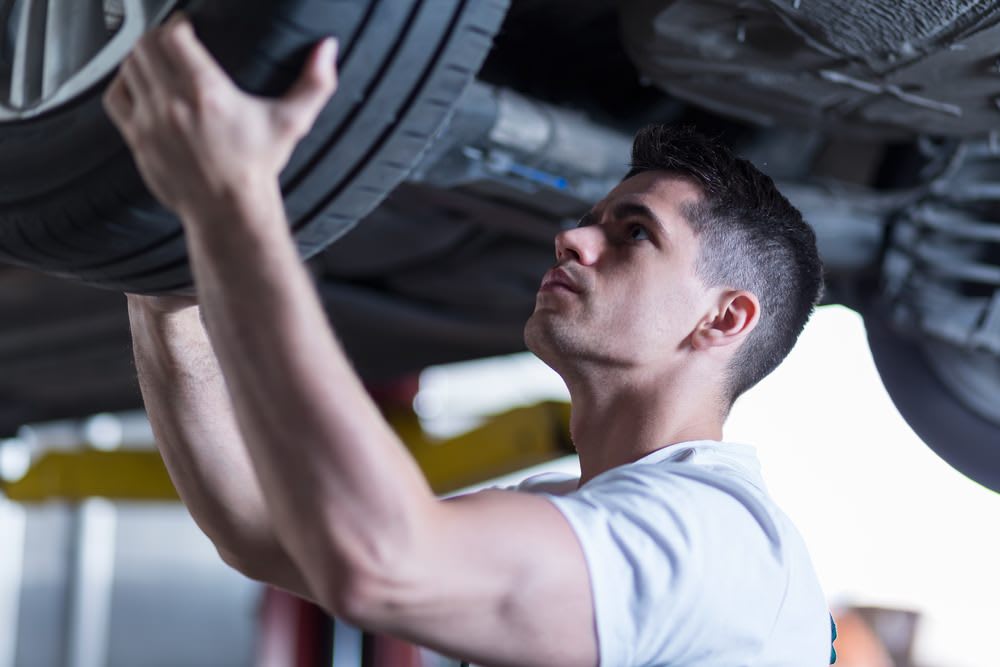

No car, truck, or SUV is going to last forever, but keeping your vehicle working well for as long as possible will save you both headaches and money. Also, keeping your vehicle’s suspension in good working order will mean you’re getting the most out of your vehicle in terms of handling, ride, and most importantly, safety. With that in mind, what should you do to maximize the lifespan of your vehicle’s suspension?
The suspension is composed of hundreds of different parts, and vehicles vary tremendously in suspension designs, but every suspension has to do three things: hold the vehicle up, absorb bumps and other road shocks, and turn the vehicle in response to the driver’s input. To accomplish these tasks, the system is composed of the following major parts and subsystems:
Wheels and tires. Many drivers don’t think of tires as part of the suspension, but they’re arguably the most important part. Tires provide traction for acceleration, braking, and cornering, as well as absorbing smaller bumps.
Springs. Every car and truck today has some sort of springs, which support the vehicle and absorb large bumps.
Shock absorbers. While springs absorb the bumps, shock absorbers (or, in cars that have them, struts) dampen the motion of the springs after a bump, keeping them from bouncing up and down excessively.
Linkages. A complete compilation of suspension linkages would fill a book, but every suspension includes various arms, rods, and other connecting pieces that collectively keep the wheels where they’re supposed to be relative to the rest of the vehicle. Most of these linkages are solid metal parts.
Bushings, bearings, and joints. Because most parts of the suspension have to be able to move, the various linkages are connected by flexible connections.
Steering system. Whether the steering is considered a separate system or part of the suspension, its operation is intimately connected to the suspension as it directs how the front wheels respond to driver commands. Every steering system includes a steering “box,” which converts rotation of the steering wheel to movement of the vehicle’s wheels, as well as linkages to connect everything; vehicles equipped with power steering also include either a hydraulic system including fluid lines and a pump, or several electrical motors.
Each of the major part types listed above requires attention, but some require much more than others. If you’re interested in making everything last as long as possible, you’ll want to do the following:
Check your tires’ air. This is probably the easiest maintenance to perform, and may be the most important. Properly inflated tires (check your manual for the correct pressure) help protect the rest of the suspension from damage; under-inflation costs you money in extra fuel while hurting handling and braking performance; if the tires are seriously low on air, the car won't even be safe to drive. Check inflation at least every couple thousand miles.
Check your tires’ tread. When you check the tires’ air pressure, check the tread too. The minimum legal tread depth is 1/16 of an inch (check it by placing a penny in one of the grooves; if you can’t cover up any of Lincoln’s head, you don’t have 1/16 depth). However, many experts recommend at least 1/8 inch for safe driving (use a nickel instead of a penny; the top of Jefferson’s head is 1/8 of an inch from the edge of the coin), and even more is best for driving in snowy conditions. Regardless, watch for uneven wear, which means there’s another problem (usually misalignment).
Get your wheels aligned. Proper alignment improves handling, reduces tire wear, and is necessary for safety. An alignment every two years or 30,000 miles is a minimum for most vehicles; if you drive on rough roads (including those with potholes) a lot, you’ll want an alignment about every year.
Check the power steering fluid and belt. If your car has hydraulic power steering, your mechanic should check the fluid level and belt tightness at every oil change or every 5,000 miles. A slipping belt or low fluid level can damage expensive power steering components, and might make your car unsafe. Also, your power steering fluid may need to be changed every 30,000 miles or so; check your owner’s manual.
Inspect the bushings and joints. At every oil change, your mechanic should (and probably will) check every suspension and steering system bushing and joint for wear or damage. Also, older vehicles’ tie rod ends and ball joints may need to be lubricated periodically. (Most modern cars and trucks have sealed joints.) Such checks and, if necessary, joint lubrication are a standard part of a wheel alignment and full-service oil changes.
Inspect the shocks. Shock absorbers and struts should be checked for leakage, as a leaking shock will soon need replacement and may contribute to damage to other suspension components. As with bushings and joints, this inspection is a normal part of wheel alignment and usually of a full-service oil change.
Have everything inspected if you’re in an accident. Most of the linkages and springs should last a long time, possibly the life of your car. But after an accident involving one or more wheels, every component of the suspension should be checked for damage.
One more thing: the way you drive, and where you do it, matters too. Suspensions are designed to cope with bumps, but over time they cause wear to various components; driving rapidly over speed bumps, potholes, and similar large bumps can shorten the life of the system.
Because every vehicle’s suspension is composed of so many connected parts, wear or damage to one part can sometimes damage others. The best approach to keeping your suspension working well for as long as possible is to check for wear on a regular basis, and fix any problem as soon as you find it rather than letting the damage — and the eventual cost — build up.



